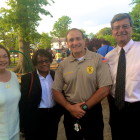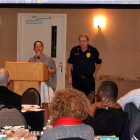When the Community Coalition on Race approached the South Orange Village Trustees in November about passing a resolution condemning actions in Ferguson, MO, a very interesting thread arose from the thoughtful discussion.
Trustees praised the South Orange — and Maplewood — police departments, citing their longstanding work to connect with the communities they protect.
While acknowledging the serious social, policing and judicial issues exposed in Ferguson, Trustee Sheena Collum said she was worried about “creeping anti-police sentiment” and wanted to call attention to the work of the South Orange Police Department. “I’m very proud of our police department,” she said. Village President Alex Torpey and Trustee Walter Clarke made similar comments.
The police chiefs noticed.
“I was very impressed that they said that and … in the forum that they did. It was great to hear,” said Chief Robert Cimino of the Maplewood Police Department.
Maplewood
Maplewood Police Chief Robert Cimino has spent his entire 33-year law enforcement career in Maplewood where he became chief more than 14 years ago.
“We’ve operated from the theory of community-oriented policing for years — since the concept started to come about in the 1980s and then started to be communicated more through policing ranks into the 90s.” Cimino said a simple explanation of community policing is that it is “about making officers aware of building partnerships and relationships in the community” as well as representing the goals and values of the community. “So we encourage them to get out, go to block parties. That’s part of our standard. We want them to … engage the people in the neighborhoods and speak to them, not just be a face behind a closed car as they drive through a community.”
Toward that end, Maplewood has integrated community policy ideals and goals in its mission statement and core values — both of which can be found on the MPD website. “We expect that [officers] are embodying those in their everyday job,” said Cimino, who added, “We review that with officers periodically.” Cimino said that the accreditation process with the NJ State Association of Chiefs of Police —recently completed by the MPD — re-enforces these values: “It acknowledges that we are an agency that is using best practices.”
Cimino said that the Maplewood PD backs its mission and core values with active programs including a youth engagement program where several times each year the Maplewood police put together events such as “the game truck.”
Officers in the game truck interact with local youth by playing video games with them. “They get to know each other,” said Cimino. “The kids see officers as persons rather than uniformed police officers. The kids see officers in a more relaxed environment.”
Cimino said that the town has also been improving the diversity of the police force. “In the last 15 years or so we’ve greatly improved the diversity among the ranks of the officers to more closely represent the ranks of the community.” Cimino said that this has been achieved by actively working to recruit officers from local colleges with diverse populations. “We’re mindful of the diversity of the community as we do recruitment processes and continue to seek to improve that.”
Cimino said that, using the definition of “minority” as it appears in the Federal EEOC literature, the Maplewood PD would be considered 30% minority. (According to the 2010 U.S. Census, the population of Maplewood is more than 35% minority.) “If one were to include females, considering they do have minority status under the law,” said Cimino, “the Maplewood Police Department would be 40% minority.”
Officers also participate in periodic, required sensitivity and diversity training. “But we also look to find new programs periodically to use as a point of acknowledgement for the officers so that they are mindful of the diversity,” Cimino said. “We keep that in mind if we find extra training … we can try to institute that and we talk about that as part of other training.”
Other Maplewood police efforts include:
- Working with and to form neighborhood associations. The police crime prevention unit links with these groups, as does the Chief. “I will go out in certain instances and speak directly to those groups,” said Cimino.
- “We have several foot patrol posts,” said Cimino, where police can interact with the public on a face-to-face basis. Cimino said that there was a static post in Maplewood Village at school closing time (Maplewood Middle School is nearby) and on Saturdays. There is a walking post officer on Irvington Avenue during the day. “This time of year we will extend their hours because more people are out on the street because of the holiday season,” said Cimino. On Springfield Avenue, two officers do a “walk and talk” in the afternoons.
- At the high school, the Maplewood PD has a school outreach officer spending time at the school at the end of the day to interact with the students —usually on Thursdays and Fridays, said Cimino.
- The D.A.R.E. program — “It’s a great starting point to interact with the community at the start of adolescence — 4th and 5th grade — in the classroom promoting anti-drug and positive self image lessons,” said Cimino. “It’s the first interaction for a lot of kids with uniformed police officers. A lot of kids will remember their D.A.R.E. officer.”
- The Maplewood PD Youth Aid Bureau has implemented the Station House Adjustment Program, which “law enforcement agencies may use to handle first-time juvenile offenders who have committed minor juvenile delinquency offenses within their jurisdiction.” Said Cimino, “We strived for that before it was institutionalized. When I started in Maplewood, our Youth Aid Bureau 33 years ago was working from the same mindset … help them within the community rather than put them into the system.” Youth Aid Officers are also very active with afterschool and weekend programs like YouthNet.
South Orange
“One thing I’m really proud of,” said South Orange Police Chief James Chelel, “every year going back at least seven years we’ve run the junior police academy.” This one-week summer program sponsored by local businesses gives about 25 children a week of police and law enforcement summer camp. Chelel said the program elicits “very positive feedback.”
“Someday, hopefully, one of these kids becomes a police officer,” said Chelel.
Chelel has served 30 years with the SOPD, the last eight as chief.
As in Maplewood, Chelel said South Orange was big on neighborhood watch and association programs. He commended resident Janine Buckner, who is also a professor of psychology at Seton Hall University. “The police can’t perform in a vacuum,” said Chelel. “She has developed one of the strongest [neighborhood programs] in the state. We go out to the meetings.” Chelel credited Sgt. Adrian Acevedo, who runs the SOPD community relations program as well.
Chelel said the the SOPD also stays connected with the community by working closely with houses of worship — from Baptist churches to Jewish synagogues.
Like Maplewood, the SOPD works with the middle school after-school programs through YouthNet. The Maplewood and South Orange juvenile bureaus meet monthly and provide updates on the high school (which is located in Maplewood but serves students from both towns). South Orange PD also meets regularly with Seton Hall University security staff. In addition, SOPD has adopted the station house adjustment program.
Chelel cited the Domestic Violence Response Team which is a shared program with Maplewood as another community outreach effort. Volunteer team members receive training, working with the police departments, and “come out when domestic violence occurs in the community.”
Chelel spoke proudly of the work of the South Orange Community Emergency Response Team (CERT), a new effort that has sprung from the severe weather events of the last few years. “We’re trying to get members of the community to assist when a storm happens,” said Chelel. He credited Deputy Village Administrator Adam Loehner and Trustee Sheena Collum for “driving” this program, which also connects with Seton Hall University. “When a disaster happens or something large scale, [CERT] is more or less helping with water and setting up shelters, maybe blocking off traffic. Where we are understaffed, they can provide resources.”
Police officers also walk the beat in South Orange in the Village Center. “They know all the store owners and meet all the kids. A lot of the kids come out,” said Chelel.
Finally, Chelel said that South Orange has been working to make the diversity of the police force more closely match the community. Chelel said that South Orange’s population is at present 28% minority. “Our police department is right on par with that —23%.” But, he said, workforce diversity is “something we want to work on, we want to support.” Chelel said that South Orange was more restricted in its recruitment procedures than Maplewood: “We are civil service. We have to hire off of that list.”
All in all, Chelel is proud of his force: “They are all good guys, good men and women.”
Chelel is not alone in his assessment.
“From the standpoint of our police department, one of the reasons they are able to be as effective as they are is not just the skills and hard work of the officers, and growing use of technology, but it is also because of the trust our residents largely have in them, and the residents’ willingness to contact and work with the police, and basically be partners in keeping our neighborhoods safe with them,” wrote South Orange Village President Alex Torpey in an email to The Village Green.
Torpey continued: “Our officers make an extra effort, beyond all the community-focused programming they do, to just be trust-building in their daily work, which I’ve seen first hand from many hundreds of calls on the Rescue Squad.”
In Maplewood, Mayor Vic DeLuca said that town leaders “have worked with Chief Cimino to strengthen the Department’s capacity to positively interact with all members of our community.” DeLuca echoed Cimino’s comments about taking deliberate steps to diversify the police force and institute sensitivity training “so that our officers are more culturally competent in dealing with a diverse population.”
In addition, DeLuca said that the township has held quarterly meetings between Chief Cimino and neighborhood leaders through the Maplewood Community Action Project. “These practices help us work toward the goals we aspire to reach, including having a safe, vibrant community in which the police and all people are respected and treated with dignity and fairness. There is more that needs to happen including having a broader conversation in this country about race relations, our justice system, and policing strategies in an increasingly diverse nation.”
Is there room for improvement? Everyone interviewed said yes.
“There are definitely places that have a lot of work to do specifically and we still have a long way to go as a country but in the meantime, I do hope that in South Orange we can continue to try to find ways to keep doing better,” said Torpey, “and I hope that our story can serve as some inspiration and in part a model for others working towards better community-police relations, safer neighborhoods and more diverse, inclusive and integrated communities.”
“Police work is very hard,” said DeLuca, “and we support and thank those on the front lines protecting our families and property.”
With community policing, Cimino said, “It’s a job that’s never really finished.”



